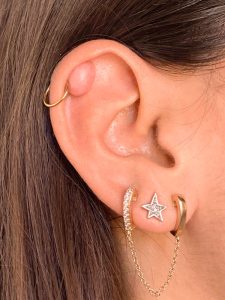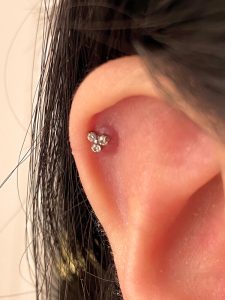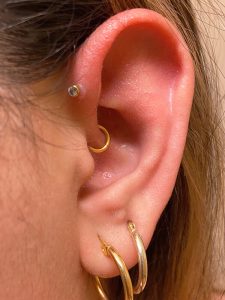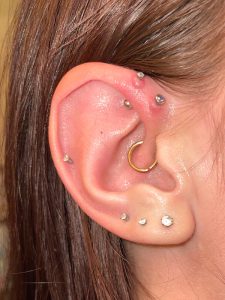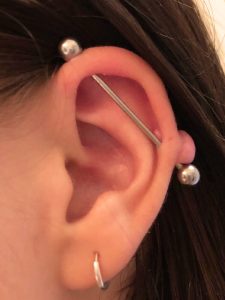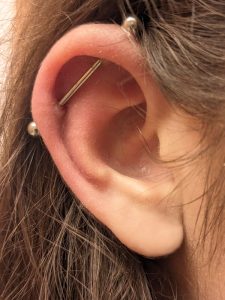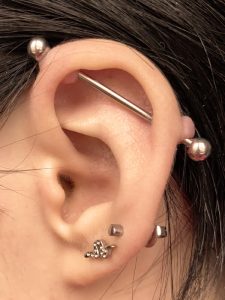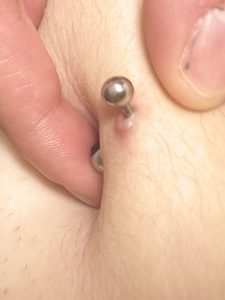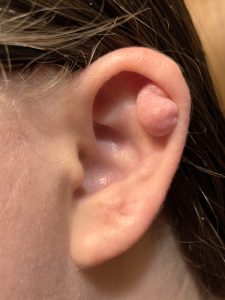Are you struggling with bumps or raised scars around your piercings? Getting a body piercing is an exciting decision, but sometimes the healing process doesn’t go as smoothly as expected. If you’re experiencing a piercing bump or a keloid, it can be frustrating and confusing to know what’s going on. That’s why we’ve created this guide to help you identify and understand the differences between piercing bumps and keloids.
Whether you’re new to body piercings or a seasoned pro, this article will equip you with the knowledge you need to make informed decisions about your body and how to take care of it. So let’s jump right in and explore piercing bumps and keloids.
Key Points
What Are Piercing Bumps?
Piercing bumps are small, raised areas around new or existing body piercings. They usually develop due to irritation, infection, or the body’s natural response to the piercing. These bumps tend to be small, round or oval, and have a reddish or flesh-toned color. The texture is softer, like skin itself, and you’ll typically find them close to the piercing site.
These bumps are more common in cartilage, navel, surface, and industrial piercings. They often show up during the healing process, which varies depending on the piercing type.
Let’s break down a few types of piercing bumps:
- Hypertrophic scarring: Raised, reddish bumps due to scar tissue overgrowth. They improve with proper care.
- Pustules: Small, pus-filled bumps caused by irritation or infection. Keep the area clean for faster healing.
- Granulomas: Small, fleshy bumps caused by the body’s immune response. They improve with consistent care.
Characteristics of piercing bumps include:
- Small, round or oval shape
- Reddish or flesh-toned color
- Softer texture, similar to skin
- Located close to the piercing site
What causes Piercing Bumps?
Piercing bumps can be unsightly and sometimes painful, but they are generally harmless. There are several factors that contribute to the development of piercing bumps:
- Infection: Improper care allows bacteria entry, causing inflammation and piercing bumps.
- Allergic reaction: Metal allergies can trigger inflammation and bump formation.
- Poor quality jewelry: Low-quality or ill-fitting jewelry can irritate tissue, leading to bumps.
- Trauma: Repeated pressure or snagging can cause bumps to form.
- Overcleaning: Stripping natural oils creates dryness and irritation, contributing to bumps.
- Inadequate aftercare: Ignoring aftercare instructions can result in complications, including bumps.
What Are Keloids?
Piercing keloids are a type of scar that forms due to collagen overproduction during healing. They’re more common in people with a genetic predisposition to keloid formation. Keloids are larger, irregular, and often extend beyond the original wound. They usually have a darker color, which may range from pink to red or brown.
Keloids have a firmer, rubbery texture that sets them apart from regular piercing bumps. They can form around the piercing site and may extend beyond it. Piercing keloids can occur in any type of piercing but are more likely to appear in piercings with longer healing times. Keloids often develop months or years after the initial piercing.
Characteristics of piercing keloids include:
- Larger size with an irregular shape
- Darker color, may become shiny or discolored
- Firmer, rubbery texture
- May extend beyond the original wound
What causes keloids?
Piercing keloids are thick, raised scars that can form around a piercing site. Several factors contribute to the development of keloids:
- Genetic predisposition: Heightened response to skin injuries may cause keloids.
- Skin type: Darker skin tones or family history increase keloid risk.
- Piercing location: Earlobes, chest, and back are more prone to keloids.
- Infection: Bacterial infections can worsen scarring and induce keloids.
- Improper aftercare: Neglecting aftercare instructions raises keloid risk.
- Trauma: Repeated irritation or pressure exacerbates scarring, leading to keloids.
What’s the difference between keloids and piercing bumps?
The main differences between keloids and piercing bumps involve their duration, appearance, and cause. Piercing bumps are usually temporary and tend to resolve on their own with proper care. On the other hand, keloids are permanent and might need medical intervention.
Additionally, piercing bumps are smaller with a softer texture, while keloids are larger, have an irregular shape, and a firmer, rubbery texture. Regardless of the piercing location, whether it’s cartilage, nose, or ear, the differences between piercing bumps (such as hypertrophic scars) and keloids remain the same.
It’s essential to understand the difference between a piercing bump and a keloid to ensure a safe and healthy healing process. By learning how to identify these issues and knowing when to seek professional help, you can minimize the risk of complications and enjoy your body piercing with confidence.
| Feature | Piercing Bump | Piercing Keloid |
|---|---|---|
| Definition | Small, raised areas around a piercing | Type of scar due to overproduction of collagen |
| Cause | Irritation, infection, body’s natural response | Genetic predisposition, healing process |
| Common Piercing Types | Cartilage, navel, surface, industrial | Cartilage, surface, other types |
| Healing Time | Appears during healing process | Develops months or years after the piercing |
| Size and Shape | Smaller, round or oval | Larger, irregular shape |
| Color | Reddish or flesh-toned | Darker, may become shiny or discolored |
| Texture | Softer, similar to skin | Firmer, rubbery |
| Location | Close to the piercing site | Around or beyond the original wound |
How to get rid of piercing bumps?
Getting rid of piercing bumps might seem challenging, but don’t worry! We’re here to guide you through the process with some helpful tips. Just remember to be patient, as healing can take time.
- Keep it clean: Make sure to clean the piercing area with a saline solution or an antiseptic recommended by your piercer. This helps prevent infection and promotes healing. Avoid using alcohol or hydrogen peroxide, as they can be too harsh and slow down the healing process.
- Avoid touching: Resist the urge to touch or pick at the bump, as this can introduce bacteria and worsen the situation. Always wash your hands thoroughly before handling your piercing or changing the jewelry.
- Opt for hypoallergenic jewelry: Make sure your piercing jewelry is made of hypoallergenic materials, such as surgical steel, titanium, or niobium, to avoid irritation and allergic reactions.
- Apply a warm compress: Soak a clean cloth in warm saline solution and gently press it against the bump for a few minutes, 1-2 times a day. This can help reduce swelling and promote healing.
- Consider over-the-counter treatments: Tea tree oil or hydrocortisone cream can help alleviate irritation and swelling. However, use these treatments sparingly and follow the product’s instructions carefully. If you’re unsure, consult a healthcare professional before using any new products.
- Give it time: Remember that healing can take time, so try to be patient. If the bump doesn’t improve after several weeks or if you notice signs of infection (such as redness, warmth, or pus), it’s essential to consult a healthcare professional for further advice.
How to get rid of keloids?
Dealing with keloids can be a bit tricky, but don’t worry! We’re here to help you navigate the process with some useful tips. Remember that treating keloids might require professional assistance, so be prepared to consult a healthcare professional.
- Consult a dermatologist: If you suspect you have a keloid, it’s important to see a dermatologist for a proper evaluation and treatment plan. They can recommend the best course of action based on the keloid’s size, location, and severity.
- Topical treatments: Your dermatologist might recommend a topical silicone gel or cream to help flatten and reduce the keloid’s appearance. Be sure to follow their instructions and apply the treatment consistently for the best results.
- Corticosteroid injections: In some cases, your dermatologist may suggest corticosteroid injections to help shrink the keloid. These injections are typically administered every 3-4 weeks until the keloid reduces in size or disappears.
- Cryotherapy: This treatment involves freezing the keloid with liquid nitrogen, which can help shrink it and improve its appearance. Cryotherapy may be used alone or in combination with other treatments, depending on your specific situation.
- Laser therapy: Some dermatologists may offer laser therapy to help reduce the size and appearance of keloids. This treatment can also help improve the keloid’s color and texture, making it less noticeable.
- Surgical removal: In rare cases, surgical removal of the keloid may be recommended. However, this option carries a risk of the keloid recurring or even growing larger. It’s essential to discuss the potential risks and benefits with your dermatologist before opting for surgery.
- Preventative measures: If you’re prone to keloids, take steps to prevent them from forming. This may include avoiding piercings or tattoos, treating minor skin injuries promptly, and applying silicone sheets or gel to healing wounds.
Piercing bump vs keloid pictures
To gain a clearer understanding of the differences between piercing bumps and keloids, examining images that compare the two can be quite informative. While these pictures may help you identify common characteristics, it is important to consult a professional piercer or dermatologist if you are uncertain or concerned about a bump near your piercing. This will ensure a safe and accurate assessment.

